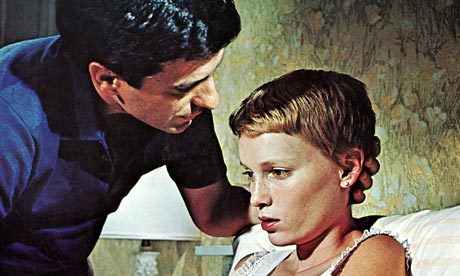The Terror Inside: ‘Rosemary’s Baby’ and ‘Black Swan’ By Alissa Wilkinson
By Yasmina Tawil

Baby girls get swaddled in pink, all sweetness and light, cooing little bundles of cotton candy. We sing them lullabies, play melodies on music boxes that cradle spinning ballerinas, nestle them between pillows and puffy stuffed rabbits. They grow. They pull on tiny pink tutus and soft pink canvas slippers and spin on their toes, glowing with joy. They grow. They have soft, cooing babies of their own.
Invert these saccharine trimmings of infancy and girlhood, though, and they grow sinister—a photonegative of innocence, a fleeing from the light. The opening titles of Rosemary’s Baby signal that such an inversion is happening before our eyes. While a pink script announces what you’re about to see in a self-consciously girlish manner, the eerie, wordless lullaby prickles your neck, and the camera’s perspective—hovering and descending over Manhattan—implies that a presence is about to alight, once it finds its mark: The Bramford, where Rosemary and her husband Guy are looking to rent an apartment and, soon, start a family.

I don’t know what it’s like to watch Rosemary’s Baby in a man’s body, but I know my body thrills sickeningly with primal terror. Mia Farrow’s Rosemary seems at first both scrappy and brave; she chooses the apartment, she initiates sex, she oversees renovations, she is confident and happy and plenty capable of standing up to others if she wants. She isn’t a model of twenty-first century feminism, but she’s no shrinking violet, either.
Yet her body, growing another being, undoes her. Impregnated without her own participation—either by Satan or by her husband, who cheerfully informs her the morning after that she’d passed out so he’d just gone ahead anyhow—she rapidly becomes merely a vessel, to be shaped and scolded by everyone else: Guy, doctors who tell her not to read, Minnie Castavet and her foul smoothies. And maybe Satan’s spawn, from the inside.
The longer this goes on, the more isolated Rosemary becomes. She’s not a prisoner in her apartment, but she seems like one, with her bouncing bundle of joy turned to tiny jailer inside. Guy roams freely, and so do the Castavets, who seem to be everywhere. But Rosemary is basically housebound, left alone in the domestic realm with her thoughts, her fears, her pains, and the sounds she hears through the walls. It’s a recipe for disaster.
In an essay included with the Criterion release of Rosemary’s Baby, Ira Levin explained the origin of his novel. “Having observed that the most suspenseful part of a horror story is before, not after, the horror appears,” Levin wrote, “I was struck one day by the thought … that a fetus could be an effective horror if the reader knew it was growing into something malignly different from the baby expected. Nine whole months of anticipation, with the horror inside the heroine!”





